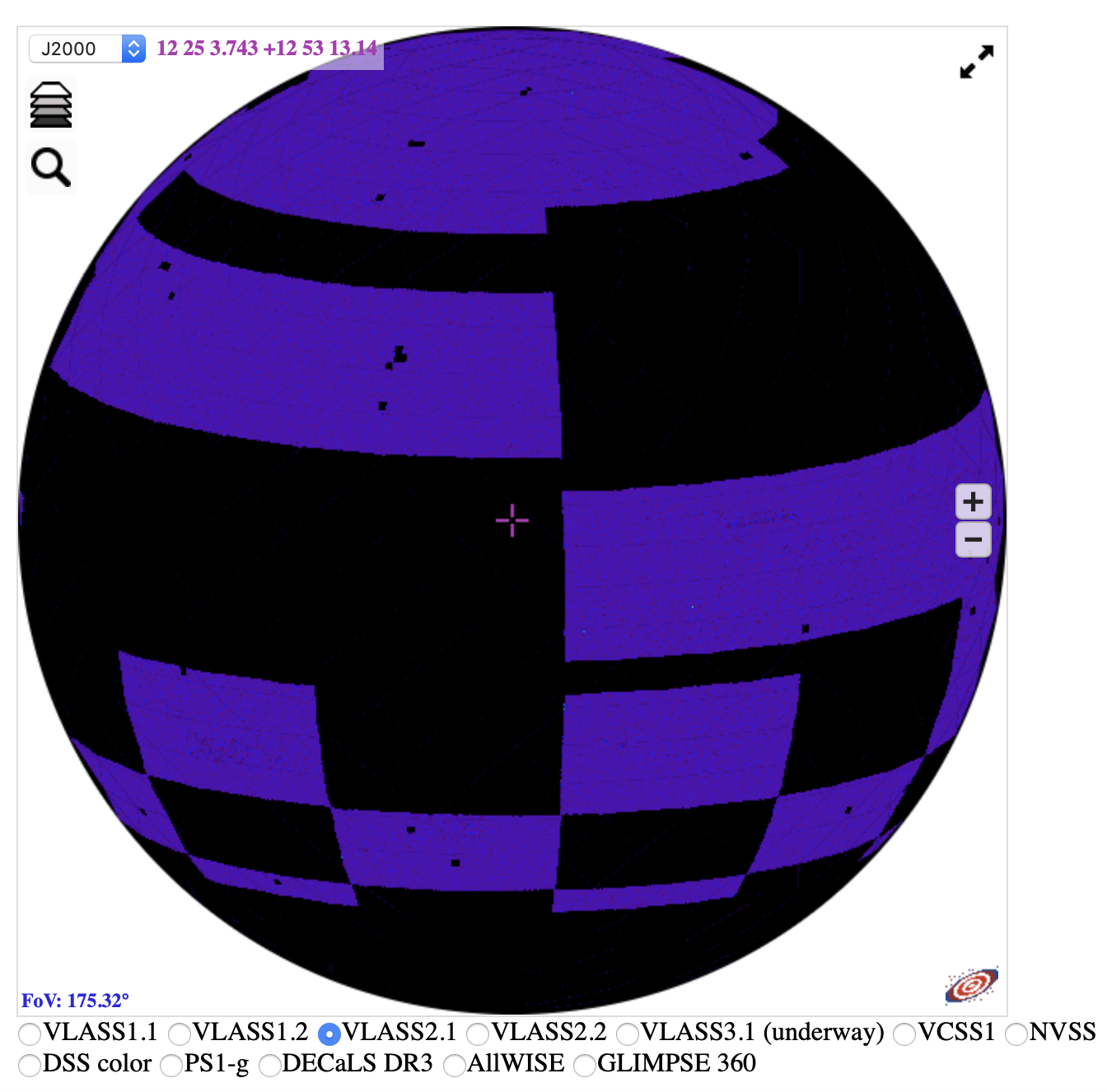VLA Sky Survey

|
|
The Very Large Array Sky Survey (VLASS) is a community-driven initiative to carry out a synoptic radio sky survey using the Karl G. Jansky Very Large Array (VLA). |
VLASS Epoch 4.1 Commenced!Posted 2025 Sept 5 by S.T.Myers On August 26, observations commenced for the final epoch of the VLA Sky Survey, VLASS4.1. The first pipeline generated images are now flowing into the archive and in the Quick-Look image cache. The VLASS4.1 campaign data will function as a 4th epoch for half the sky and the data will be used to create a set of Single Epoch products in lieu of those from VLASS 1.1, which suffered from an antenna pointing issue.VLASS4.1 observations will conclude on February 9th 2026. (Updates STM 2025-09-10): First QL HiPS images for VLASS4.1 now posted here. Will keep updating this throughout observing and QL processing. VLASS at AAS245106.02 iPoster (Monday 1/13/25) "The Discovery of a Newborn Quasar Jet Hosted by a Spiral Galaxy" Olivia Achenbach (United States Naval Academy); Kristina Nyland (NRL); Mark Lacy (NRAO); Henrique Schmitt (NRL). 118.03 (Monday 1/13/25 10:20 - 10:30 AM ET) "An update on the VLA Sky Survey" Mark Lacy (NRAO); VLASS team (NRAO). Mark Lacy (NRAO) in Splinter Session "Maximizing Science with Roman-Rubin Data Synergies" (Wednesday 1/15/25 10:00 - 11:30 AM ET) and do not miss the NRAO Town Hall session 169 (Monday 1/13/25 6:30 - 8:30 PM ET in Potomac Ballroom C. VLASS Splinter Session at AAS242"Explorer's Guide to the VLA Sky Survey (VLASS)"Tuesday, June 6, 2023, 9am - 3pm MDT Session recordings, presentation slides, and other links are available here. We thank those who attended in-person or online for their participation and interest. |
Explore the VLA Sky!We have created an Interactive HiPS Image containing all the currently available epochs of VLASS as well as links to other useful sky survey images. Median Stacked Quicklook full-sky images now available!Jansky Fellow Dillon Dong has made median stacks of the Quick Look images from the three VLASS epochs. These images are deeper than the individual per epoch Quick Look images and, being medians, also have fewer artifacts.The images are available in the Archive Cache, and an interactive HiPS image is available here. Note - the root URL link to VLASS images at NRAO has recently changed from archive-new.nrao.edu/vlass to to vlass-dl.nrao.edu/vlass. Images may be found at vlass-dl.nrao.edu/vlass/quicklook, vlass-dl.nrao.edu/vlass/se_continuum_imaging and vlass-dl.nrao.edu/vlass/HiPS. |
 |
|
Our partners at CIRADA have made available a Cutout Service that includes VLASS Quicklook Images. Also available are VLASS Source Catalogs. |
 |
Survey Description:
VLASS will eventually use ~ 5500 hours (extended to ~ 6400 hours for Epoch 4.1) to cover the whole sky visible at the VLA (δ > -40 deg), a total of 33,885 deg². The survey is designed to engage radio astronomy experts, multi-wavelength astronomers, and citizen scientists alike. The data are being acquired in three epochs to allow the discovery of transient radio sources; are calibrated in Stokes I, Q and U; and cover the frequency range 2–4 GHz with an angular resolution of ~ 2.5 arcsec. The 1σ sensitivity goal for a single pass is 120 μJy, or 69 μJy when all three passes are combined. Observing began in September 2017 and the survey finished observing the first 3 full epochs in 2024. In 2024, a further 4.1 half-epoch was approved to be observed. By utilizing an “on the fly” interferometry mode, the observing overheads are much reduced compared to a conventional pointed survey.
| Epoch | Start | End | Status |
| Pilot | Jun 2016 | Sep 2016 | obs, QL complete, HiPS: QL |
| 1.1 | Sep 2017 | Feb 2018 | obs, QL v2 complete, HiPS: QL |
| 1.2 | Mar 2019 | Jul 2019 | obs, QL v2 complete, HiPS: QL |
| 2.1 | Jun 2020 | Oct 2020 | obs, QL complete, HiPS: QL SE* |
| 2.2 | Oct 2021 | Mar 2022 | obs, QL complete, HiPS: QL SE* |
| 3.1 | Jan 2023 | Jun 2023 | obs, QL complete, HiPS: QL |
| 3.2 | May 2024 | Oct 2024 | obs, QL complete, HiPS: QL SE* |
| 4.1 | Oct 2025 | Feb 2026 | observing ongoing, HiPS: QL* |
* partial or in progress
Quick Links:
Note - the root URL link to VLASS images at NRAO has recently changed from archive-new.nrao.edu/vlass to to vlass-dl.nrao.edu/vlass. Images may be found at vlass-dl.nrao.edu/vlass/quicklook, vlass-dl.nrao.edu/vlass/se_continuum_imaging and vlass-dl.nrao.edu/vlass/HiPS.
User contributed software page
Motivation: In the 20 years since the initial observations were made for the NRAO VLA Sky Survey (NVSS) and the Faint Images of the Radio Sky at Twenty-Centimeters (FIRST), these pioneering programs have defined the state-of-the-art in centimeter radio sky surveys and produced a steady stream of excellent science. The astronomy community recognized that several of the high priority science goals of the 2010 decadal survey New Worlds, New Horizons in Astronomy and Astrophysics could be addressed by a new VLA sky survey. Many scientists expressed keen interest in a new, wide-area centimeter wavelength sky surveys in support of multi-wavelength synoptic surveys using existing and future facilities, such as the Vera C. Rubin Observatory.





Connect with NRAO